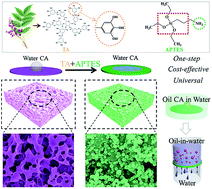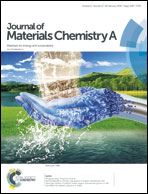One-step transformation of highly hydrophobic membranes into superhydrophilic and underwater superoleophobic ones for high-efficiency separation of oil-in-water emulsions†
Abstract
Superhydrophilic membranes have drawn much attention owing to their outstanding anti-fouling performance and ultrahigh permeation flux for wastewater treatment and oil–water separation. Since most widely used polymer membranes have high intrinsic hydrophobicity, a universal approach for superhydrophilic modification is highly required. Yet, how to simply transform highly hydrophobic membranes into superhydrophilic ones is still a challenge. Herein, we develop a one-step and general strategy to achieve the hydrophobic-to-superhydrophilic transformation of commercial membranes on the basis of catechol chemistry, i.e., co-deposition of tannic acid (TA) and 3-aminopropyltriethoxysilane (APTES) in aqueous solution. Owing to the distinct adhesion properties of TA and the reaction between the oxidative product of TA and the hydrolysis product of APTES, hydrophilic and hierarchical layer-colloidal nanospheres can be in situ assembled on various highly hydrophobic membranes including polyvinylidene fluoride (PVDF), polypropylene (PP), polytetrafluoroethylene (PTFE), copper mesh, stainless steel wire, and nylon mesh. The resulting superhydrophilic membrane can realize high-efficiency separation of various oil-in-water emulsions.



 Please wait while we load your content...
Please wait while we load your content...